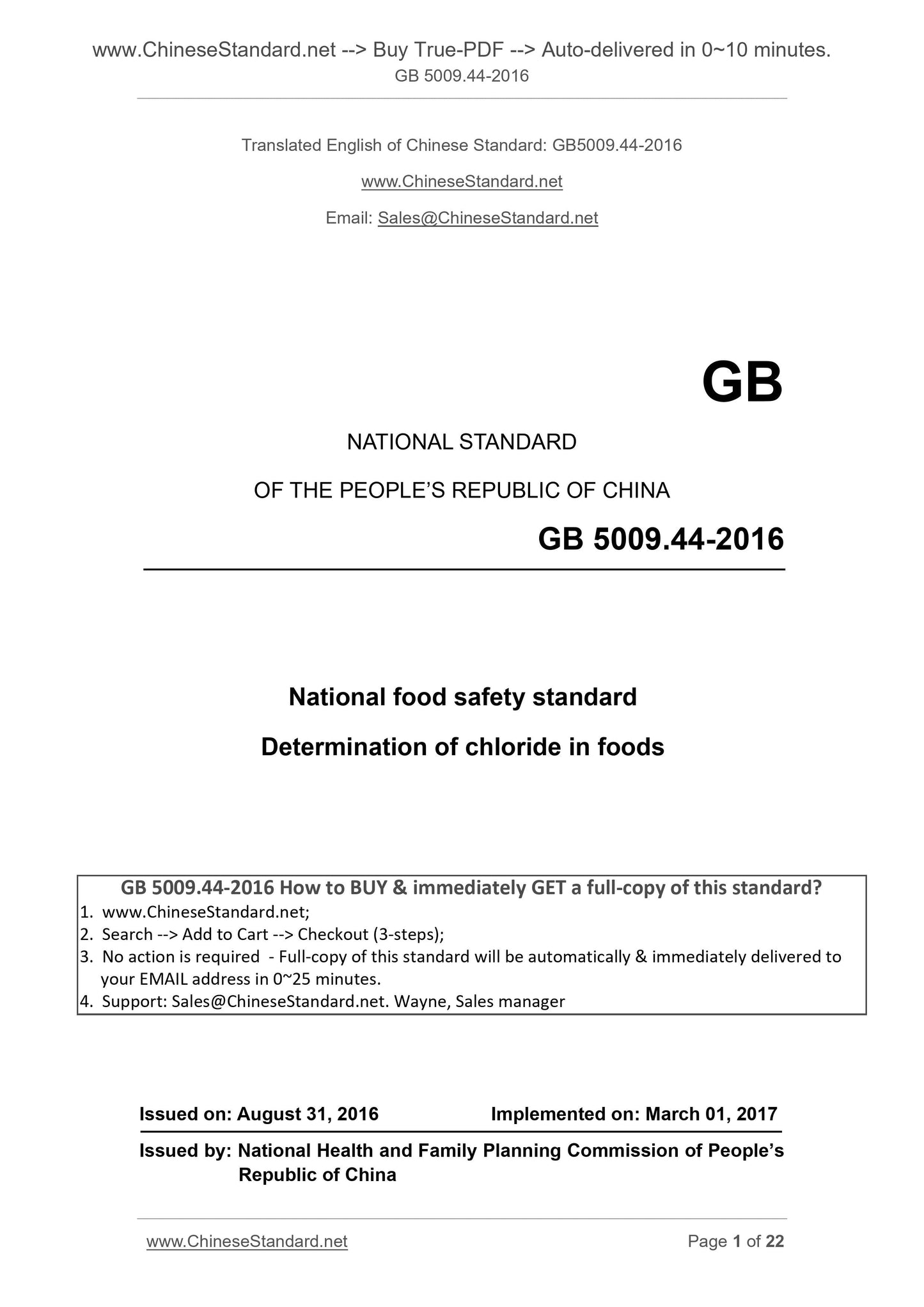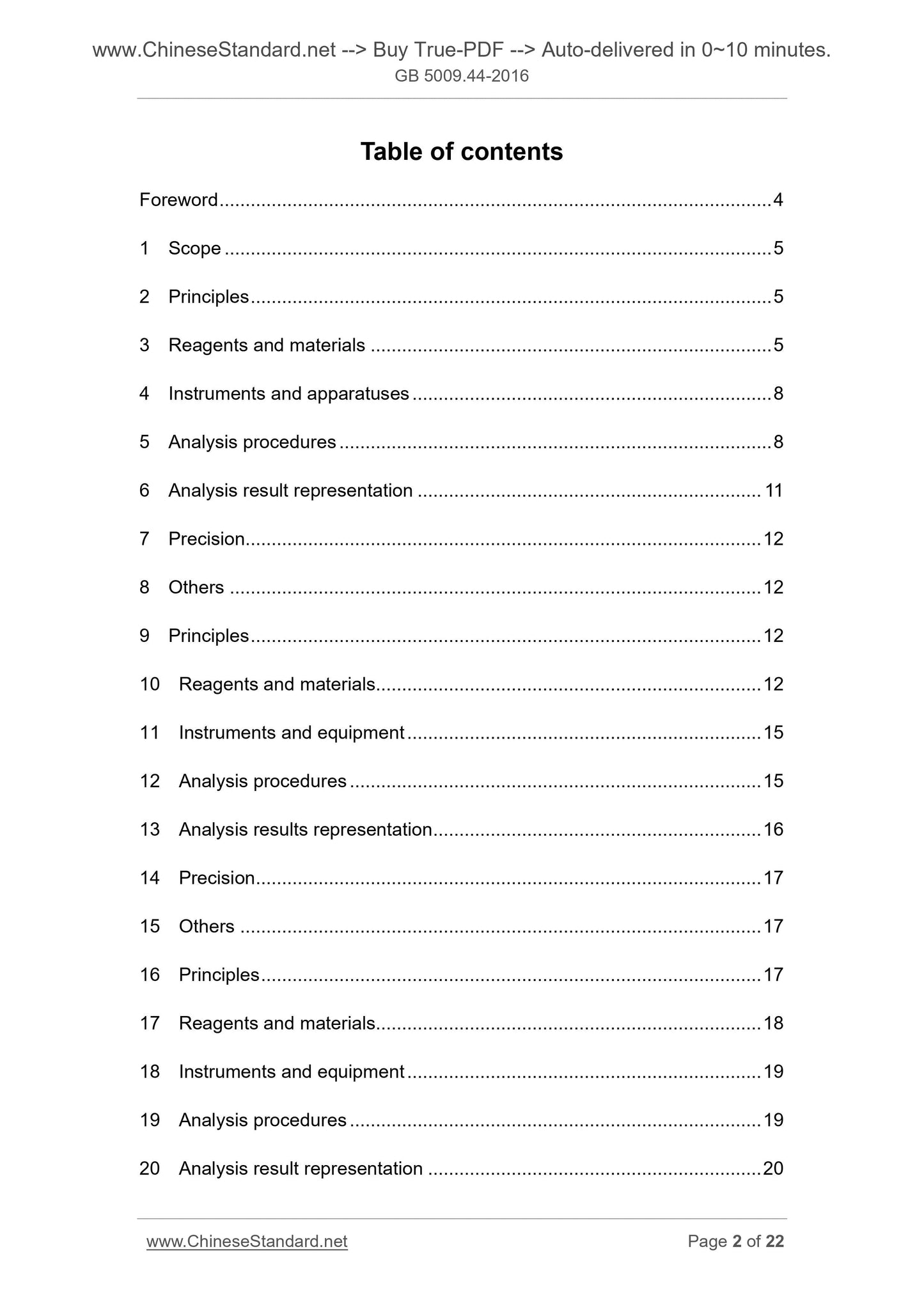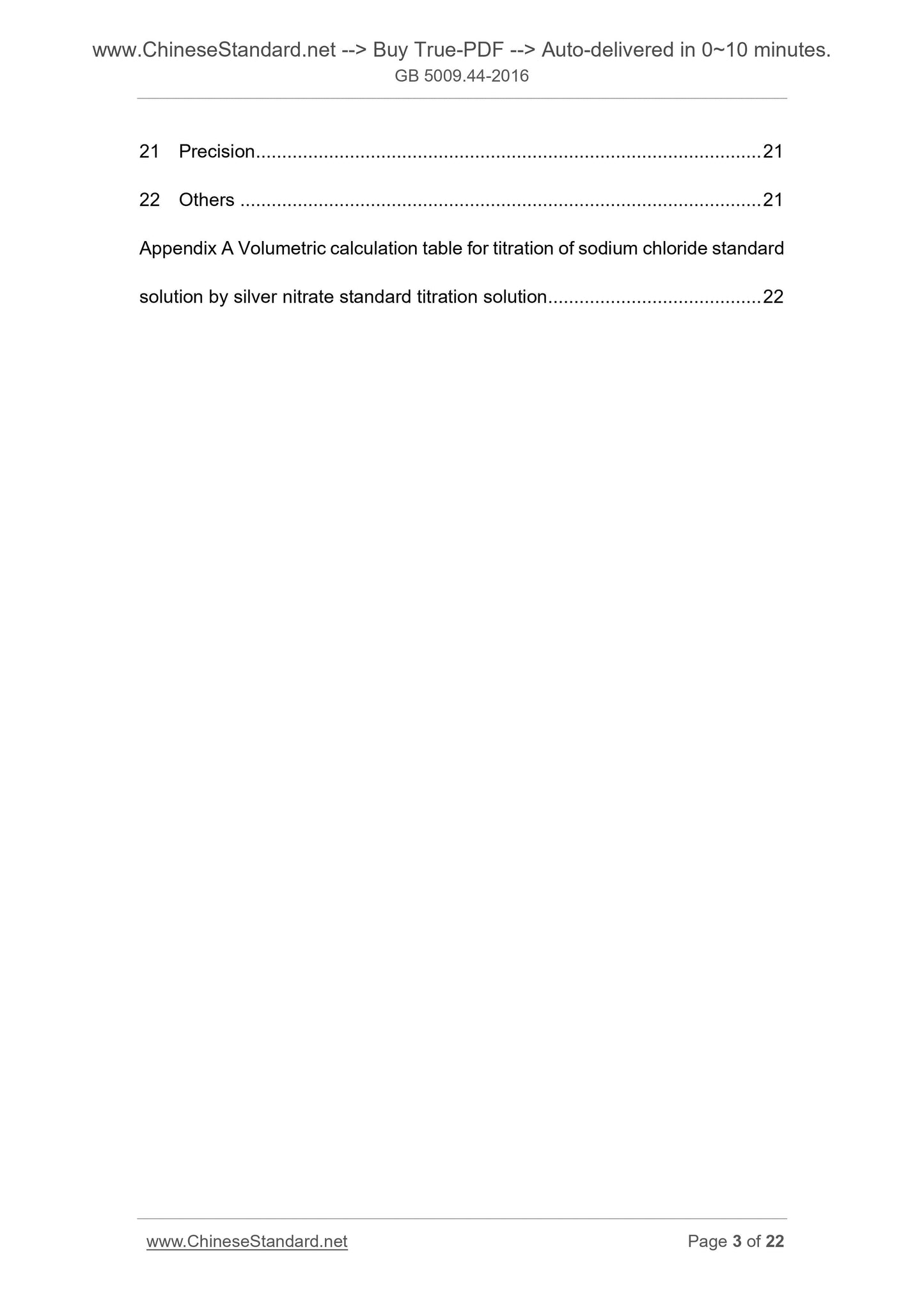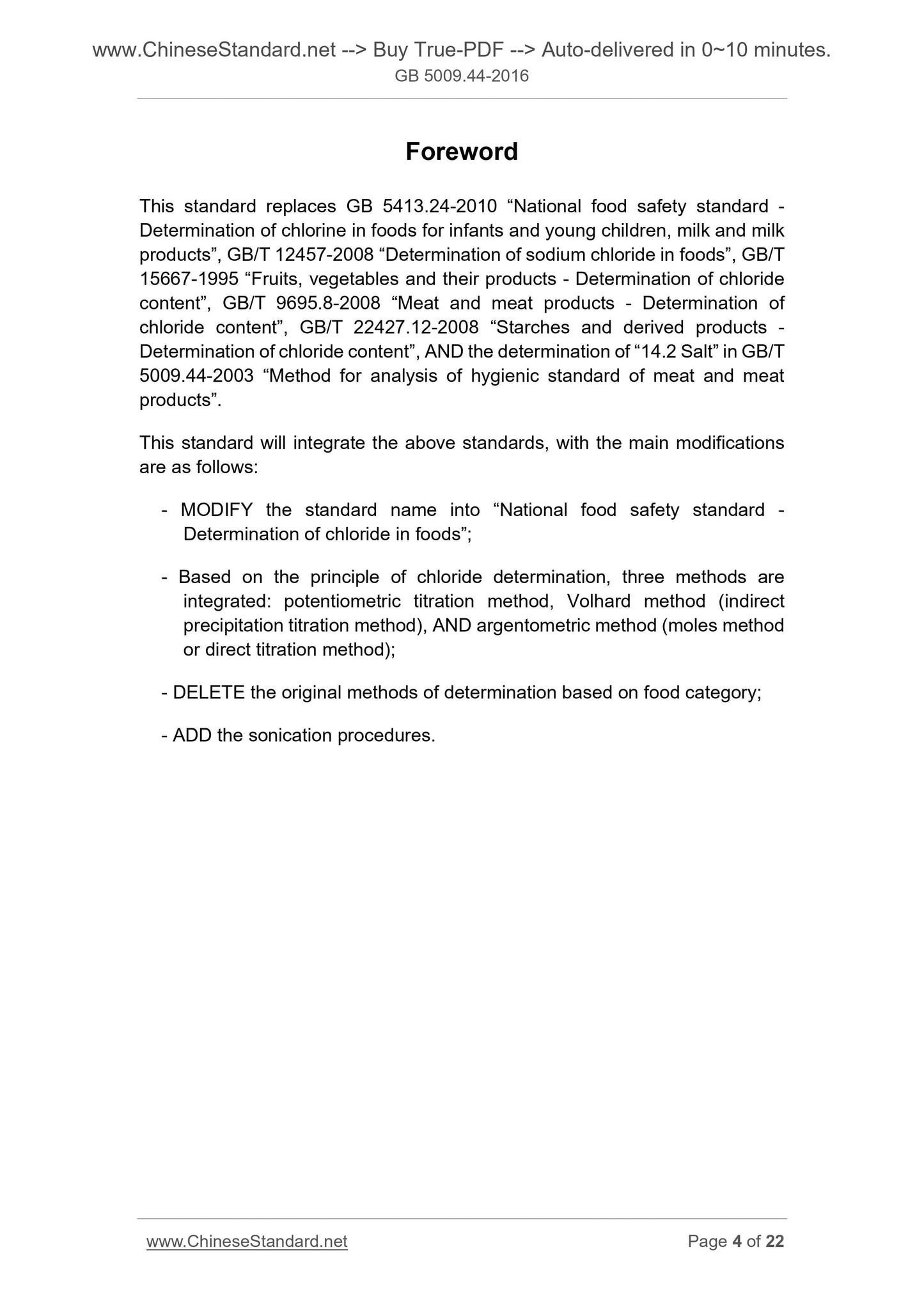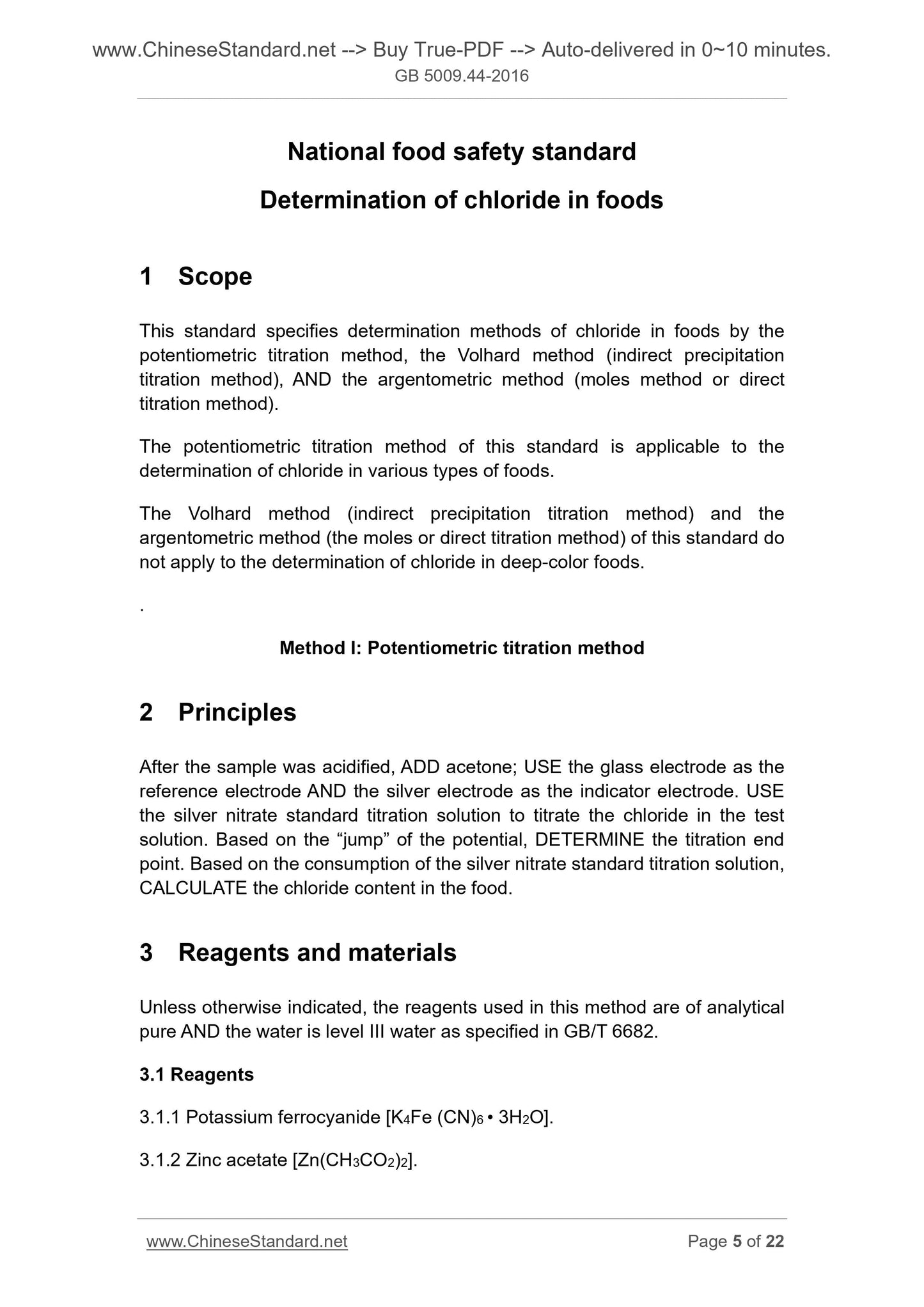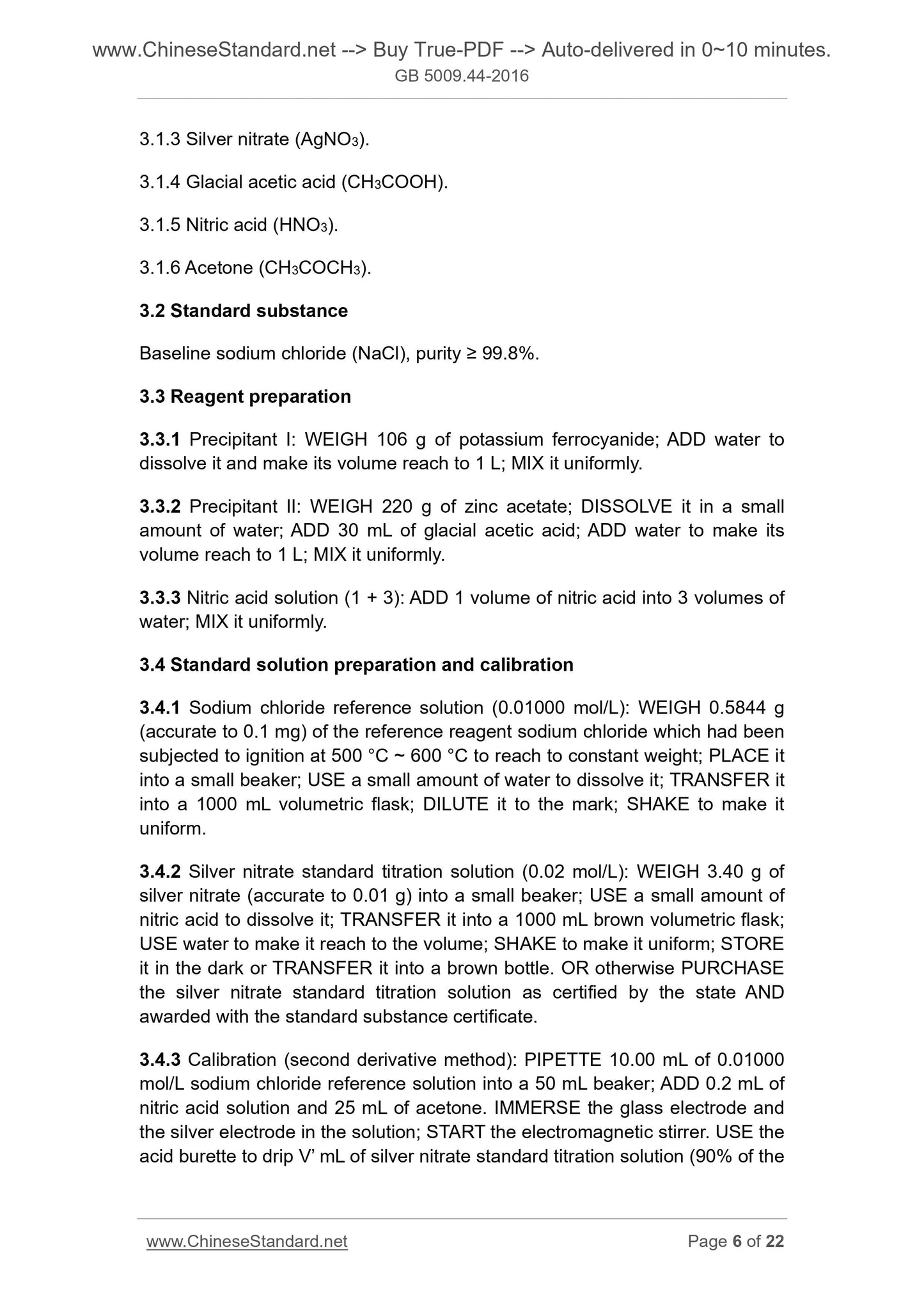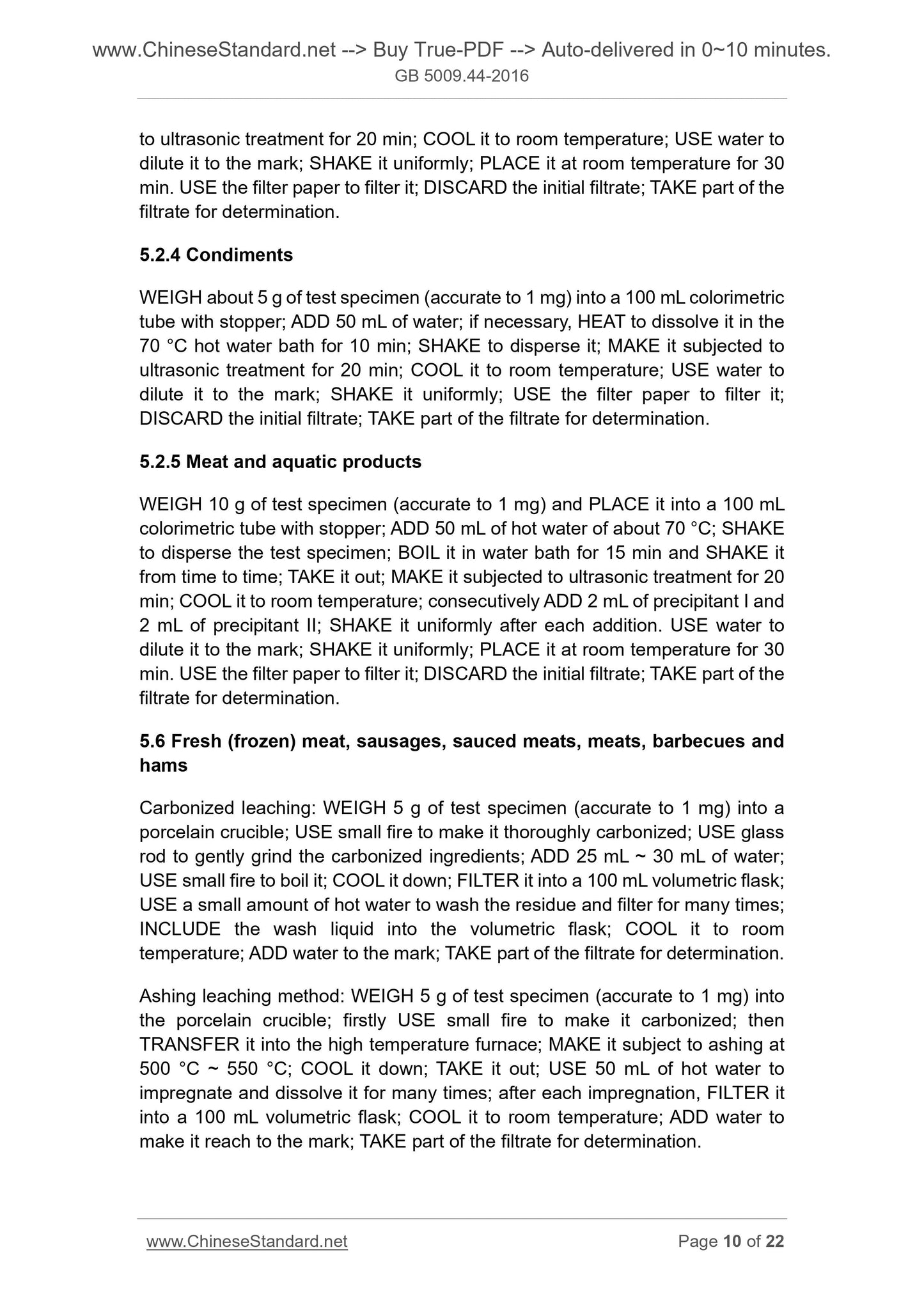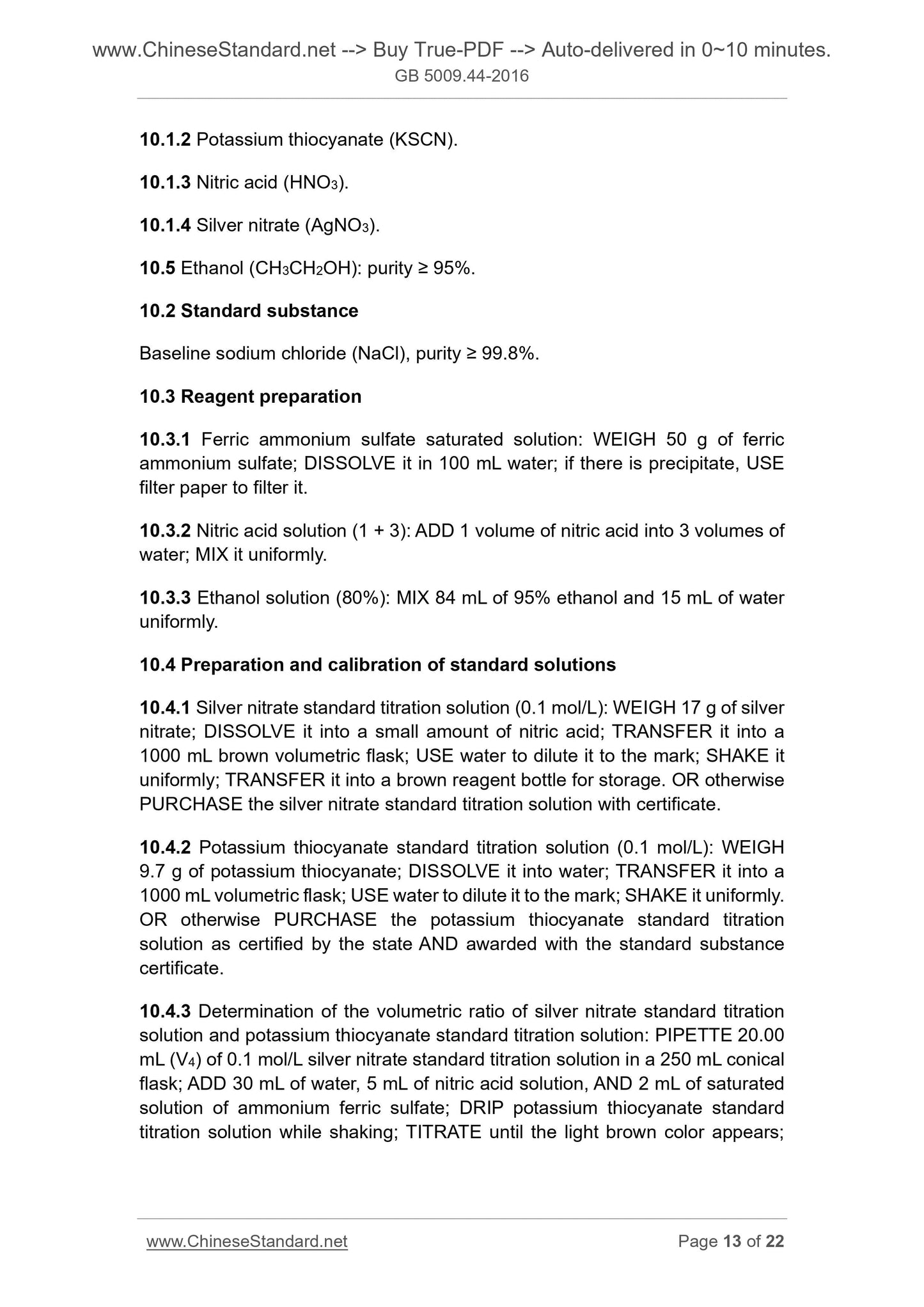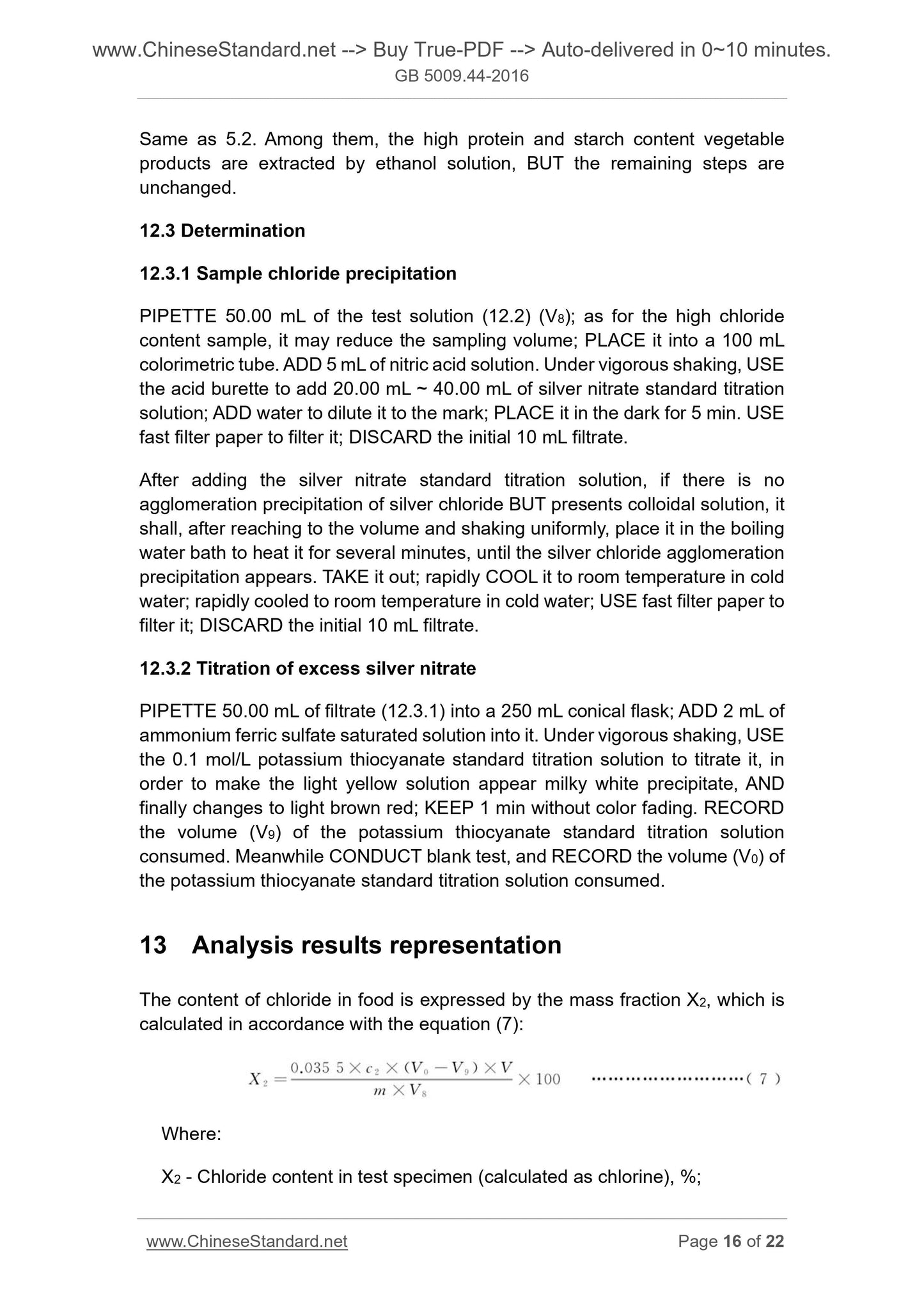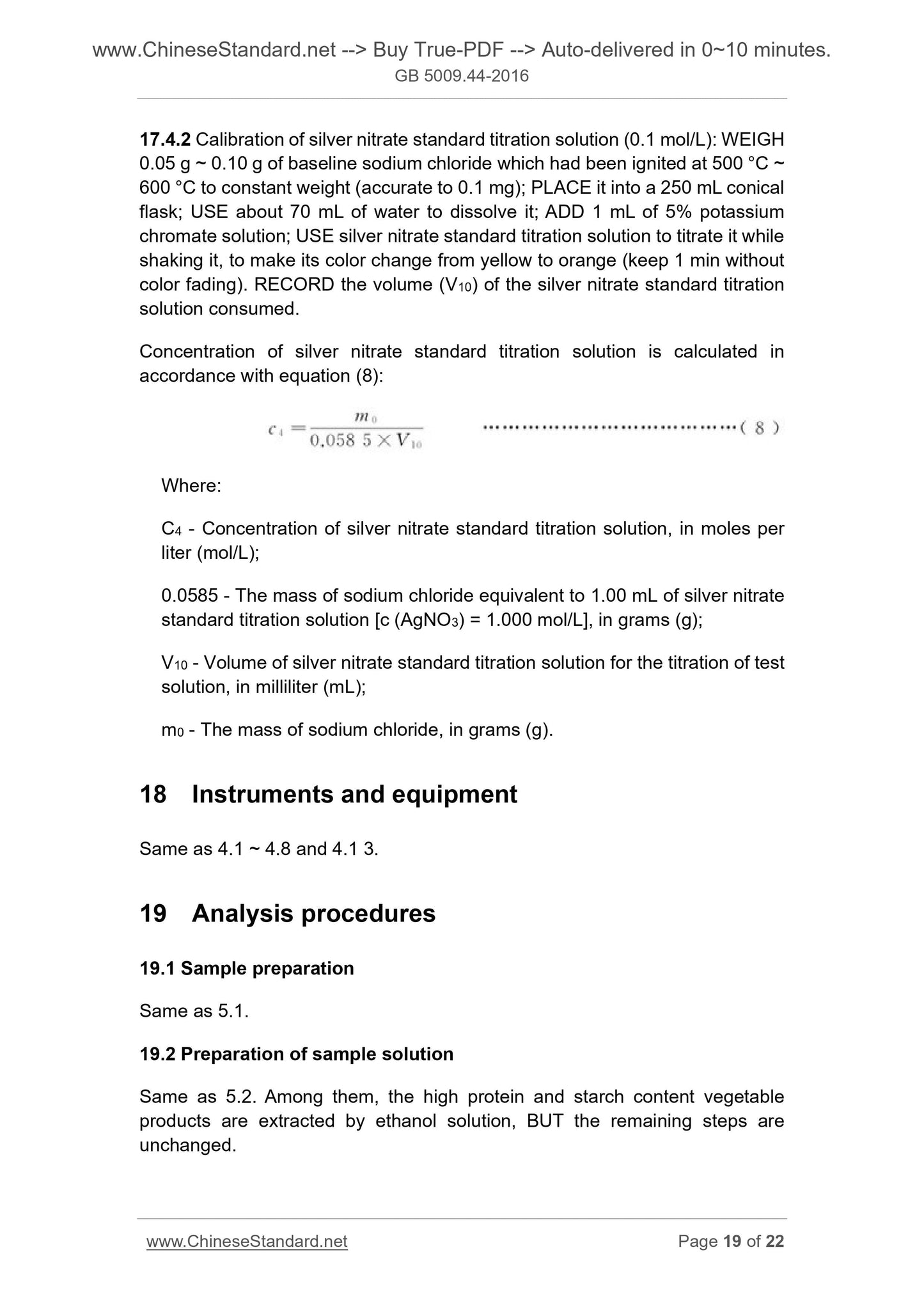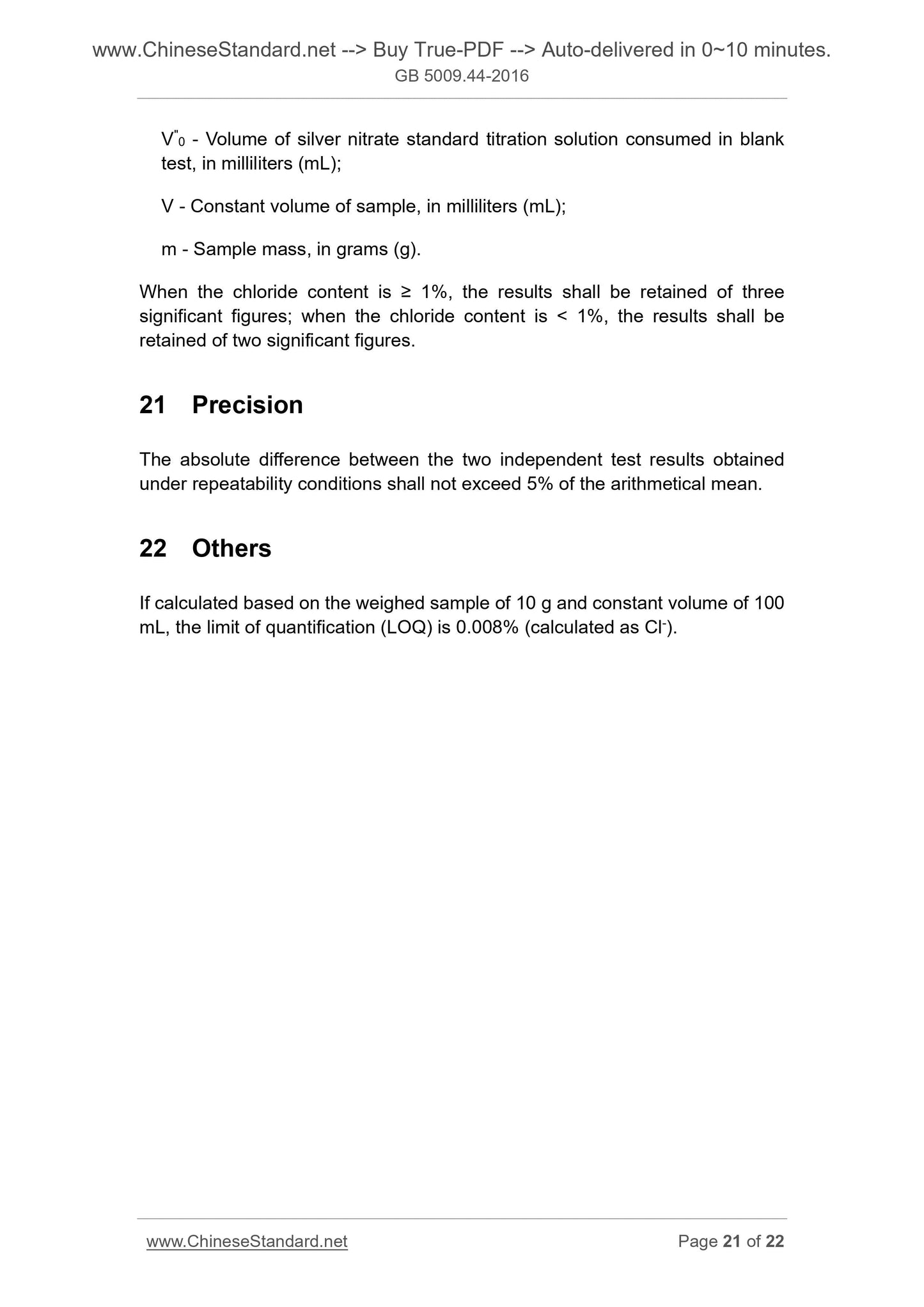1
/
of
11
www.ChineseStandard.us -- Field Test Asia Pte. Ltd.
GB 5009.44-2016 English PDF
GB 5009.44-2016 English PDF
Regular price
$125.00
Regular price
Sale price
$125.00
Unit price
/
per
Shipping calculated at checkout.
Couldn't load pickup availability
GB 5009.44-2016: National food safety standard Determination of chloride in foods
Delivery: 9 seconds. Download (& Email) true-PDF + Invoice.
Get Quotation: Click GB 5009.44-2016 (Self-service in 1-minute)
Historical versions (Master-website): GB 5009.44-2016
Preview True-PDF (Reload/Scroll-down if blank)
GB 5009.44-2016
GB
NATIONAL STANDARD
OF THE PEOPLE’S REPUBLIC OF CHINA
National food safety standard
Determination of chloride in foods
ISSUED ON. AUGUST 31, 2016
IMPLEMENTED ON. MARCH 01, 2017
Issued by. National Health and Family Planning Commission of People’s
Republic of China
Table of contents
Foreword ... 4
1 Scope ... 5
2 Principles ... 5
3 Reagents and materials ... 5
4 Instruments and apparatuses ... 8
5 Analysis procedures ... 8
6 Analysis result representation ... 11
7 Precision... 12
8 Others ... 12
9 Principles ... 12
10 Reagents and materials... 12
11 Instruments and equipment ... 15
12 Analysis procedures ... 15
13 Analysis results representation ... 16
14 Precision ... 17
15 Others ... 17
16 Principles ... 17
17 Reagents and materials... 18
18 Instruments and equipment ... 19
19 Analysis procedures ... 19
20 Analysis result representation ... 20
21 Precision ... 21
22 Others ... 21
Appendix A Volumetric calculation table for titration of sodium chloride standard
solution by silver nitrate standard titration solution ... 22
Foreword
This standard replaces GB 5413.24-2010 “National food safety standard -
Determination of chlorine in foods for infants and young children, milk and milk
products”, GB/T 12457-2008 “Determination of sodium chloride in foods”, GB/T
15667-1995 “Fruits, vegetables and their products - Determination of chloride
content”, GB/T 9695.8-2008 “Meat and meat products - Determination of
chloride content”, GB/T 22427.12-2008 “Starches and derived products -
Determination of chloride content”, AND the determination of “14.2 Salt” in GB/T
5009.44-2003 “Method for analysis of hygienic standard of meat and meat
products”.
This standard will integrate the above standards, with the main modifications
are as follows.
- MODIFY the standard name into “National food safety standard -
Determination of chloride in foods”;
- Based on the principle of chloride determination, three methods are
integrated. potentiometric titration method, Volhard method (indirect
precipitation titration method), AND argentometric method (moles method
or direct titration method);
- DELETE the original methods of determination based on food category;
- ADD the sonication procedures.
National food safety standard
Determination of chloride in foods
1 Scope
This standard specifies determination methods of chloride in foods by the
potentiometric titration method, the Volhard method (indirect precipitation
titration method), AND the argentometric method (moles method or direct
titration method).
The potentiometric titration method of this standard is applicable to the
determination of chloride in various types of foods.
The Volhard method (indirect precipitation titration method) and the
argentometric method (the moles or direct titration method) of this standard do
not apply to the determination of chloride in deep-color foods.
Method I. Potentiometric titration method
2 Principles
After the sample was acidified, ADD acetone; USE the glass electrode as the
reference electrode AND the silver electrode as the indicator electrode. USE
the silver nitrate standard titration solution to titrate the chloride in the test
solution. Based on the “jump” of the potential, DETERMINE the titration end
point. Based on the consumption of the silver nitrate standard titration solution,
CALCULATE the chloride content in the food.
3 Reagents and materials
Unless otherwise indicated, the reagents used in this method are of analytical
pure AND the water is level III water as specified in GB/T 6682.
3.1 Reagents
3.1.1 Potassium ferrocyanide [K4Fe (CN)6 • 3H2O].
3.1.2 Zinc acetate [Zn(CH3CO2)2].
3.1.3 Silver nitrate (AgNO3).
3.1.4 Glacial acetic acid (CH3COOH).
3.1.5 Nitric acid (HNO3).
3.1.6 Acetone (CH3COCH3).
3.2 Standard substance
Baseline sodium chloride (NaCl), purity ≥ 99.8%.
3.3 Reagent preparation
3.3.1 Precipitant I. WEIGH 106 g of potassium ferrocyanide; ADD water to
dissolve it and make its volume reach to 1 L; MIX it uniformly.
3.3.2 Precipitant II. WEIGH 220 g of zinc acetate; DISSOLVE it in a small
amount of water; ADD 30 mL of glacial acetic acid; ADD water to make its
volume reach to 1 L; MIX it uniformly.
3.3.3 Nitric acid solution (1 + 3). ADD 1 volume of nitric acid into 3 volumes of
water; MIX it uniformly.
3.4 Standard solution preparation and calibration
3.4.1 Sodium chloride reference solution (0.01000 mol/L). WEIGH 0.5844 g
(accurate to 0.1 mg) of the reference reagent sodium chloride which had been
subjected to ignition at 500 °C ~ 600 °C to reach to constant weight; PLACE it
into a small beaker; USE a small amount of water to dissolve it; TRANSFER it
into a 1000 mL volumetric flask; DILUTE it to the mark; SHAKE to make it
uniform.
3.4.2 Silver nitrate standard titration solution (0.02 mol/L). WEIGH 3.40 g of
silver nitrate (accurate to 0.01 g) into a small beaker; USE a small amount of
nitric acid to dissolve it; TRANSFER it into a 1000 mL brown volumetric flask;
USE water to make it reach to the volume; SHAKE to make it uniform; STORE
it in the dark or TRANSFER it into a brown bottle. OR otherwise PURCHASE
the silver nitrate standard titration solution as certified by the state AND
awarded with the standard substance certificate.
3.4.3 Calibration (second derivative method). PIPETTE 10.00 mL of 0.01000
mol/L sodium chloride reference solution into a 50 mL beaker; ADD 0.2 mL of
nitric acid solution and 25 mL of acetone. IMMERSE the glass electrode and
the silver electrode in the solution; START the electromagnetic stirrer. USE the
acid burette to drip V’ mL of silver nitrate standard titration solution (90% of the
to ultrasonic treatment for 20 min; COOL it to room temperature; USE water to
dilute it to the mark; SHAKE it uniformly; PLACE it at room temperature for 30
min. USE the filter paper to filter it; DISCARD the initial filtrate; TAKE part of the
filtrate for determination.
5.2.4 Condiments
WEIGH about 5 g of test specimen (accurate to 1 mg) into a 100 mL colorimetric
tube with stopper; ADD 50 mL of water; if necessary, HEAT to dissolve it in the
70 °C hot water bath for 10 min; SHAKE to disperse it; MAKE it subjected to
ultrasonic treatment for 20 min; COOL it to room temperature; USE water to
dilute it to the mark; SHAKE it uniformly; USE the filter paper to filter it;
DISCARD the initial filtrate; TAKE part of the filtrate for determination.
5.2.5 Meat and aquatic products
WEIGH 10 g of test specimen (accurate to 1 mg) and PLACE it into a 100 mL
colorimetric tube with stopper; ADD 50 mL of hot water of about 70 °C; SHAKE
to disperse the test specimen; BOIL it in water bath for 15 min and SHAKE it
from time to time; TAKE it out; MAKE it subjected to ultrasonic treatment for 20
min; COOL it to room temperature; consecutively ADD 2 mL of precipitant I and
2 mL of precipitant II; SHAKE it uniformly after each addition. USE water to
dilute it to the mark; SHAKE it uniformly; PLACE it at room temperature for 30
min. USE the filter paper to filter it; DISCARD the initial filtrate; TAKE part of the
filtrate for determination.
5.6 Fresh (frozen) meat, sausages, sauced meats, meats, barbecues and
hams
Carbonized leaching. WEIGH 5 g of test specimen (accurate to 1 mg) into a
porcelain crucible; USE small fire to make it thoroughly carbonized; USE glass
rod to gently grind the carbonized ingredients; ADD 25 mL ~ 30 mL of water;
USE small fire to boil it; COOL it down; FILTER it into a 100 mL volumetric flask;
USE a small amount of hot water to wash the residue and filter for many times;
INCLUDE the wash liquid into the volumetric flask; COOL it to room
temperature; ADD water to the mark; TAKE part of the filtrate for determination.
Ashing leaching method. WEIGH 5 g of test specimen (accurate to 1 mg) into...
GB 5009.44-2016
GB
NATIONAL STANDARD
OF THE PEOPLE’S REPUBLIC OF CHINA
National food safety standard
Determination of chloride in foods
ISSUED ON. AUGUST 31, 2016
IMPLEMENTED ON. MARCH 01, 2017
Issued by. National Health and Family Planning Commission of People’s
Republic of China
Table of contents
Foreword ... 4
1 Scope ... 5
2 Principles ... 5
3 Reagents and materials ... 5
4 Instruments and apparatuses ... 8
5 Analysis procedures ... 8
6 Analysis result representation ... 11
7 Precision... 12
8 Others ... 12
9 Principles ... 12
10 Reagents and materials... 12
11 Instruments and equipment ... 15
12 Analysis procedures ... 15
13 Analysis results representation ... 16
14 Precision ... 17
15 Others ... 17
16 Principles ... 17
17 Reagents and materials... 18
18 Instruments and equipment ... 19
19 Analysis procedures ... 19
20 Analysis result representation ... 20
21 Precision ... 21
22 Others ... 21
Appendix A Volumetric calculation table for titration of sodium chloride standard
solution by silver nitrate standard titration solution ... 22
Foreword
This standard replaces GB 5413.24-2010 “National food safety standard -
Determination of chlorine in foods for infants and young children, milk and milk
products”, GB/T 12457-2008 “Determination of sodium chloride in foods”, GB/T
15667-1995 “Fruits, vegetables and their products - Determination of chloride
content”, GB/T 9695.8-2008 “Meat and meat products - Determination of
chloride content”, GB/T 22427.12-2008 “Starches and derived products -
Determination of chloride content”, AND the determination of “14.2 Salt” in GB/T
5009.44-2003 “Method for analysis of hygienic standard of meat and meat
products”.
This standard will integrate the above standards, with the main modifications
are as follows.
- MODIFY the standard name into “National food safety standard -
Determination of chloride in foods”;
- Based on the principle of chloride determination, three methods are
integrated. potentiometric titration method, Volhard method (indirect
precipitation titration method), AND argentometric method (moles method
or direct titration method);
- DELETE the original methods of determination based on food category;
- ADD the sonication procedures.
National food safety standard
Determination of chloride in foods
1 Scope
This standard specifies determination methods of chloride in foods by the
potentiometric titration method, the Volhard method (indirect precipitation
titration method), AND the argentometric method (moles method or direct
titration method).
The potentiometric titration method of this standard is applicable to the
determination of chloride in various types of foods.
The Volhard method (indirect precipitation titration method) and the
argentometric method (the moles or direct titration method) of this standard do
not apply to the determination of chloride in deep-color foods.
Method I. Potentiometric titration method
2 Principles
After the sample was acidified, ADD acetone; USE the glass electrode as the
reference electrode AND the silver electrode as the indicator electrode. USE
the silver nitrate standard titration solution to titrate the chloride in the test
solution. Based on the “jump” of the potential, DETERMINE the titration end
point. Based on the consumption of the silver nitrate standard titration solution,
CALCULATE the chloride content in the food.
3 Reagents and materials
Unless otherwise indicated, the reagents used in this method are of analytical
pure AND the water is level III water as specified in GB/T 6682.
3.1 Reagents
3.1.1 Potassium ferrocyanide [K4Fe (CN)6 • 3H2O].
3.1.2 Zinc acetate [Zn(CH3CO2)2].
3.1.3 Silver nitrate (AgNO3).
3.1.4 Glacial acetic acid (CH3COOH).
3.1.5 Nitric acid (HNO3).
3.1.6 Acetone (CH3COCH3).
3.2 Standard substance
Baseline sodium chloride (NaCl), purity ≥ 99.8%.
3.3 Reagent preparation
3.3.1 Precipitant I. WEIGH 106 g of potassium ferrocyanide; ADD water to
dissolve it and make its volume reach to 1 L; MIX it uniformly.
3.3.2 Precipitant II. WEIGH 220 g of zinc acetate; DISSOLVE it in a small
amount of water; ADD 30 mL of glacial acetic acid; ADD water to make its
volume reach to 1 L; MIX it uniformly.
3.3.3 Nitric acid solution (1 + 3). ADD 1 volume of nitric acid into 3 volumes of
water; MIX it uniformly.
3.4 Standard solution preparation and calibration
3.4.1 Sodium chloride reference solution (0.01000 mol/L). WEIGH 0.5844 g
(accurate to 0.1 mg) of the reference reagent sodium chloride which had been
subjected to ignition at 500 °C ~ 600 °C to reach to constant weight; PLACE it
into a small beaker; USE a small amount of water to dissolve it; TRANSFER it
into a 1000 mL volumetric flask; DILUTE it to the mark; SHAKE to make it
uniform.
3.4.2 Silver nitrate standard titration solution (0.02 mol/L). WEIGH 3.40 g of
silver nitrate (accurate to 0.01 g) into a small beaker; USE a small amount of
nitric acid to dissolve it; TRANSFER it into a 1000 mL brown volumetric flask;
USE water to make it reach to the volume; SHAKE to make it uniform; STORE
it in the dark or TRANSFER it into a brown bottle. OR otherwise PURCHASE
the silver nitrate standard titration solution as certified by the state AND
awarded with the standard substance certificate.
3.4.3 Calibration (second derivative method). PIPETTE 10.00 mL of 0.01000
mol/L sodium chloride reference solution into a 50 mL beaker; ADD 0.2 mL of
nitric acid solution and 25 mL of acetone. IMMERSE the glass electrode and
the silver electrode in the solution; START the electromagnetic stirrer. USE the
acid burette to drip V’ mL of silver nitrate standard titration solution (90% of the
to ultrasonic treatment for 20 min; COOL it to room temperature; USE water to
dilute it to the mark; SHAKE it uniformly; PLACE it at room temperature for 30
min. USE the filter paper to filter it; DISCARD the initial filtrate; TAKE part of the
filtrate for determina...
Delivery: 9 seconds. Download (& Email) true-PDF + Invoice.
Get Quotation: Click GB 5009.44-2016 (Self-service in 1-minute)
Historical versions (Master-website): GB 5009.44-2016
Preview True-PDF (Reload/Scroll-down if blank)
GB 5009.44-2016
GB
NATIONAL STANDARD
OF THE PEOPLE’S REPUBLIC OF CHINA
National food safety standard
Determination of chloride in foods
ISSUED ON. AUGUST 31, 2016
IMPLEMENTED ON. MARCH 01, 2017
Issued by. National Health and Family Planning Commission of People’s
Republic of China
Table of contents
Foreword ... 4
1 Scope ... 5
2 Principles ... 5
3 Reagents and materials ... 5
4 Instruments and apparatuses ... 8
5 Analysis procedures ... 8
6 Analysis result representation ... 11
7 Precision... 12
8 Others ... 12
9 Principles ... 12
10 Reagents and materials... 12
11 Instruments and equipment ... 15
12 Analysis procedures ... 15
13 Analysis results representation ... 16
14 Precision ... 17
15 Others ... 17
16 Principles ... 17
17 Reagents and materials... 18
18 Instruments and equipment ... 19
19 Analysis procedures ... 19
20 Analysis result representation ... 20
21 Precision ... 21
22 Others ... 21
Appendix A Volumetric calculation table for titration of sodium chloride standard
solution by silver nitrate standard titration solution ... 22
Foreword
This standard replaces GB 5413.24-2010 “National food safety standard -
Determination of chlorine in foods for infants and young children, milk and milk
products”, GB/T 12457-2008 “Determination of sodium chloride in foods”, GB/T
15667-1995 “Fruits, vegetables and their products - Determination of chloride
content”, GB/T 9695.8-2008 “Meat and meat products - Determination of
chloride content”, GB/T 22427.12-2008 “Starches and derived products -
Determination of chloride content”, AND the determination of “14.2 Salt” in GB/T
5009.44-2003 “Method for analysis of hygienic standard of meat and meat
products”.
This standard will integrate the above standards, with the main modifications
are as follows.
- MODIFY the standard name into “National food safety standard -
Determination of chloride in foods”;
- Based on the principle of chloride determination, three methods are
integrated. potentiometric titration method, Volhard method (indirect
precipitation titration method), AND argentometric method (moles method
or direct titration method);
- DELETE the original methods of determination based on food category;
- ADD the sonication procedures.
National food safety standard
Determination of chloride in foods
1 Scope
This standard specifies determination methods of chloride in foods by the
potentiometric titration method, the Volhard method (indirect precipitation
titration method), AND the argentometric method (moles method or direct
titration method).
The potentiometric titration method of this standard is applicable to the
determination of chloride in various types of foods.
The Volhard method (indirect precipitation titration method) and the
argentometric method (the moles or direct titration method) of this standard do
not apply to the determination of chloride in deep-color foods.
Method I. Potentiometric titration method
2 Principles
After the sample was acidified, ADD acetone; USE the glass electrode as the
reference electrode AND the silver electrode as the indicator electrode. USE
the silver nitrate standard titration solution to titrate the chloride in the test
solution. Based on the “jump” of the potential, DETERMINE the titration end
point. Based on the consumption of the silver nitrate standard titration solution,
CALCULATE the chloride content in the food.
3 Reagents and materials
Unless otherwise indicated, the reagents used in this method are of analytical
pure AND the water is level III water as specified in GB/T 6682.
3.1 Reagents
3.1.1 Potassium ferrocyanide [K4Fe (CN)6 • 3H2O].
3.1.2 Zinc acetate [Zn(CH3CO2)2].
3.1.3 Silver nitrate (AgNO3).
3.1.4 Glacial acetic acid (CH3COOH).
3.1.5 Nitric acid (HNO3).
3.1.6 Acetone (CH3COCH3).
3.2 Standard substance
Baseline sodium chloride (NaCl), purity ≥ 99.8%.
3.3 Reagent preparation
3.3.1 Precipitant I. WEIGH 106 g of potassium ferrocyanide; ADD water to
dissolve it and make its volume reach to 1 L; MIX it uniformly.
3.3.2 Precipitant II. WEIGH 220 g of zinc acetate; DISSOLVE it in a small
amount of water; ADD 30 mL of glacial acetic acid; ADD water to make its
volume reach to 1 L; MIX it uniformly.
3.3.3 Nitric acid solution (1 + 3). ADD 1 volume of nitric acid into 3 volumes of
water; MIX it uniformly.
3.4 Standard solution preparation and calibration
3.4.1 Sodium chloride reference solution (0.01000 mol/L). WEIGH 0.5844 g
(accurate to 0.1 mg) of the reference reagent sodium chloride which had been
subjected to ignition at 500 °C ~ 600 °C to reach to constant weight; PLACE it
into a small beaker; USE a small amount of water to dissolve it; TRANSFER it
into a 1000 mL volumetric flask; DILUTE it to the mark; SHAKE to make it
uniform.
3.4.2 Silver nitrate standard titration solution (0.02 mol/L). WEIGH 3.40 g of
silver nitrate (accurate to 0.01 g) into a small beaker; USE a small amount of
nitric acid to dissolve it; TRANSFER it into a 1000 mL brown volumetric flask;
USE water to make it reach to the volume; SHAKE to make it uniform; STORE
it in the dark or TRANSFER it into a brown bottle. OR otherwise PURCHASE
the silver nitrate standard titration solution as certified by the state AND
awarded with the standard substance certificate.
3.4.3 Calibration (second derivative method). PIPETTE 10.00 mL of 0.01000
mol/L sodium chloride reference solution into a 50 mL beaker; ADD 0.2 mL of
nitric acid solution and 25 mL of acetone. IMMERSE the glass electrode and
the silver electrode in the solution; START the electromagnetic stirrer. USE the
acid burette to drip V’ mL of silver nitrate standard titration solution (90% of the
to ultrasonic treatment for 20 min; COOL it to room temperature; USE water to
dilute it to the mark; SHAKE it uniformly; PLACE it at room temperature for 30
min. USE the filter paper to filter it; DISCARD the initial filtrate; TAKE part of the
filtrate for determination.
5.2.4 Condiments
WEIGH about 5 g of test specimen (accurate to 1 mg) into a 100 mL colorimetric
tube with stopper; ADD 50 mL of water; if necessary, HEAT to dissolve it in the
70 °C hot water bath for 10 min; SHAKE to disperse it; MAKE it subjected to
ultrasonic treatment for 20 min; COOL it to room temperature; USE water to
dilute it to the mark; SHAKE it uniformly; USE the filter paper to filter it;
DISCARD the initial filtrate; TAKE part of the filtrate for determination.
5.2.5 Meat and aquatic products
WEIGH 10 g of test specimen (accurate to 1 mg) and PLACE it into a 100 mL
colorimetric tube with stopper; ADD 50 mL of hot water of about 70 °C; SHAKE
to disperse the test specimen; BOIL it in water bath for 15 min and SHAKE it
from time to time; TAKE it out; MAKE it subjected to ultrasonic treatment for 20
min; COOL it to room temperature; consecutively ADD 2 mL of precipitant I and
2 mL of precipitant II; SHAKE it uniformly after each addition. USE water to
dilute it to the mark; SHAKE it uniformly; PLACE it at room temperature for 30
min. USE the filter paper to filter it; DISCARD the initial filtrate; TAKE part of the
filtrate for determination.
5.6 Fresh (frozen) meat, sausages, sauced meats, meats, barbecues and
hams
Carbonized leaching. WEIGH 5 g of test specimen (accurate to 1 mg) into a
porcelain crucible; USE small fire to make it thoroughly carbonized; USE glass
rod to gently grind the carbonized ingredients; ADD 25 mL ~ 30 mL of water;
USE small fire to boil it; COOL it down; FILTER it into a 100 mL volumetric flask;
USE a small amount of hot water to wash the residue and filter for many times;
INCLUDE the wash liquid into the volumetric flask; COOL it to room
temperature; ADD water to the mark; TAKE part of the filtrate for determination.
Ashing leaching method. WEIGH 5 g of test specimen (accurate to 1 mg) into...
GB 5009.44-2016
GB
NATIONAL STANDARD
OF THE PEOPLE’S REPUBLIC OF CHINA
National food safety standard
Determination of chloride in foods
ISSUED ON. AUGUST 31, 2016
IMPLEMENTED ON. MARCH 01, 2017
Issued by. National Health and Family Planning Commission of People’s
Republic of China
Table of contents
Foreword ... 4
1 Scope ... 5
2 Principles ... 5
3 Reagents and materials ... 5
4 Instruments and apparatuses ... 8
5 Analysis procedures ... 8
6 Analysis result representation ... 11
7 Precision... 12
8 Others ... 12
9 Principles ... 12
10 Reagents and materials... 12
11 Instruments and equipment ... 15
12 Analysis procedures ... 15
13 Analysis results representation ... 16
14 Precision ... 17
15 Others ... 17
16 Principles ... 17
17 Reagents and materials... 18
18 Instruments and equipment ... 19
19 Analysis procedures ... 19
20 Analysis result representation ... 20
21 Precision ... 21
22 Others ... 21
Appendix A Volumetric calculation table for titration of sodium chloride standard
solution by silver nitrate standard titration solution ... 22
Foreword
This standard replaces GB 5413.24-2010 “National food safety standard -
Determination of chlorine in foods for infants and young children, milk and milk
products”, GB/T 12457-2008 “Determination of sodium chloride in foods”, GB/T
15667-1995 “Fruits, vegetables and their products - Determination of chloride
content”, GB/T 9695.8-2008 “Meat and meat products - Determination of
chloride content”, GB/T 22427.12-2008 “Starches and derived products -
Determination of chloride content”, AND the determination of “14.2 Salt” in GB/T
5009.44-2003 “Method for analysis of hygienic standard of meat and meat
products”.
This standard will integrate the above standards, with the main modifications
are as follows.
- MODIFY the standard name into “National food safety standard -
Determination of chloride in foods”;
- Based on the principle of chloride determination, three methods are
integrated. potentiometric titration method, Volhard method (indirect
precipitation titration method), AND argentometric method (moles method
or direct titration method);
- DELETE the original methods of determination based on food category;
- ADD the sonication procedures.
National food safety standard
Determination of chloride in foods
1 Scope
This standard specifies determination methods of chloride in foods by the
potentiometric titration method, the Volhard method (indirect precipitation
titration method), AND the argentometric method (moles method or direct
titration method).
The potentiometric titration method of this standard is applicable to the
determination of chloride in various types of foods.
The Volhard method (indirect precipitation titration method) and the
argentometric method (the moles or direct titration method) of this standard do
not apply to the determination of chloride in deep-color foods.
Method I. Potentiometric titration method
2 Principles
After the sample was acidified, ADD acetone; USE the glass electrode as the
reference electrode AND the silver electrode as the indicator electrode. USE
the silver nitrate standard titration solution to titrate the chloride in the test
solution. Based on the “jump” of the potential, DETERMINE the titration end
point. Based on the consumption of the silver nitrate standard titration solution,
CALCULATE the chloride content in the food.
3 Reagents and materials
Unless otherwise indicated, the reagents used in this method are of analytical
pure AND the water is level III water as specified in GB/T 6682.
3.1 Reagents
3.1.1 Potassium ferrocyanide [K4Fe (CN)6 • 3H2O].
3.1.2 Zinc acetate [Zn(CH3CO2)2].
3.1.3 Silver nitrate (AgNO3).
3.1.4 Glacial acetic acid (CH3COOH).
3.1.5 Nitric acid (HNO3).
3.1.6 Acetone (CH3COCH3).
3.2 Standard substance
Baseline sodium chloride (NaCl), purity ≥ 99.8%.
3.3 Reagent preparation
3.3.1 Precipitant I. WEIGH 106 g of potassium ferrocyanide; ADD water to
dissolve it and make its volume reach to 1 L; MIX it uniformly.
3.3.2 Precipitant II. WEIGH 220 g of zinc acetate; DISSOLVE it in a small
amount of water; ADD 30 mL of glacial acetic acid; ADD water to make its
volume reach to 1 L; MIX it uniformly.
3.3.3 Nitric acid solution (1 + 3). ADD 1 volume of nitric acid into 3 volumes of
water; MIX it uniformly.
3.4 Standard solution preparation and calibration
3.4.1 Sodium chloride reference solution (0.01000 mol/L). WEIGH 0.5844 g
(accurate to 0.1 mg) of the reference reagent sodium chloride which had been
subjected to ignition at 500 °C ~ 600 °C to reach to constant weight; PLACE it
into a small beaker; USE a small amount of water to dissolve it; TRANSFER it
into a 1000 mL volumetric flask; DILUTE it to the mark; SHAKE to make it
uniform.
3.4.2 Silver nitrate standard titration solution (0.02 mol/L). WEIGH 3.40 g of
silver nitrate (accurate to 0.01 g) into a small beaker; USE a small amount of
nitric acid to dissolve it; TRANSFER it into a 1000 mL brown volumetric flask;
USE water to make it reach to the volume; SHAKE to make it uniform; STORE
it in the dark or TRANSFER it into a brown bottle. OR otherwise PURCHASE
the silver nitrate standard titration solution as certified by the state AND
awarded with the standard substance certificate.
3.4.3 Calibration (second derivative method). PIPETTE 10.00 mL of 0.01000
mol/L sodium chloride reference solution into a 50 mL beaker; ADD 0.2 mL of
nitric acid solution and 25 mL of acetone. IMMERSE the glass electrode and
the silver electrode in the solution; START the electromagnetic stirrer. USE the
acid burette to drip V’ mL of silver nitrate standard titration solution (90% of the
to ultrasonic treatment for 20 min; COOL it to room temperature; USE water to
dilute it to the mark; SHAKE it uniformly; PLACE it at room temperature for 30
min. USE the filter paper to filter it; DISCARD the initial filtrate; TAKE part of the
filtrate for determina...
Share
